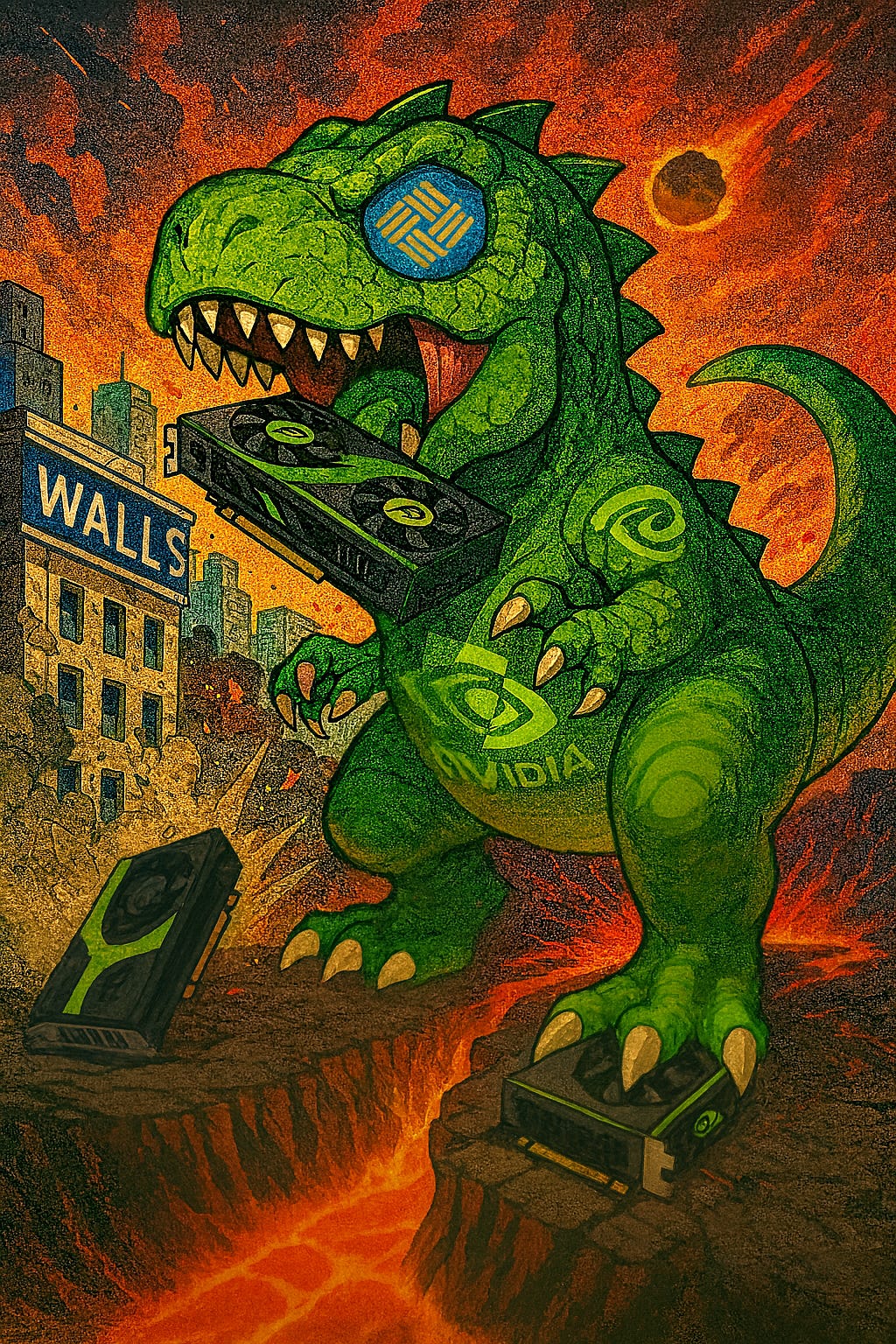NVIDIA is a juggernaut, and it looks unassailable. Nevertheless, what I’ve been writing for nearly two years now is:
That’s how Sun Microsystems looked in 1999.
Sun had the best hardware, the smartest engineers, and a market narrative that kept the share price flying up and to the right. But then the stack shifted under its feet, and the rest is history. For context, Sun bought my second startup, Infrasearch in 2001 and I worked closely with Mike Clary, Bill Joy and Andy Bechtolsheim during the 4 years I spent there. During this period Sun attempted to transition from proprietary hardware to commodity hardware, led by the Java and open source groups.
Some claim “this time it’s different,” and, to be fair, it is always different! But there is mounting evidence to support the following:
Geopolitics threatens to disrupt the status quo
Attempts are being made to replace or build around established paradigms (hardware, algorithms, development environments)
If nothing more, the market looks fragile. Let’s take a look at the latest.
The Pattern
Sun rode a wave of centralized, premium hardware sold into a rapidly expanding market (sound familiar?). Then two things collided: software and workloads refactored away from what made Sun special, and the economics of “good enough” spread through the stack with help from commoditized hardware and open source innovation.
NVIDIA faces the same risks, and even Jensen’s aware of it. NVIDIA’s valuation assumes long duration dominance selling the world’s best picks and shovels into an ever-growing demand curve.
Last week gave us three reasons to discount that assumption. One is geopolitical and hits revenue directly. The others are technical and hit the moat indirectly by demonstrating the effort being made to develop NVIDIA alternatives and proving that efficient, non-NVIDIA training and inference can be stable, fast, and good enough.
Geopolitics Impacts Economics
The most imminent risk – geopolitics – is unrelated to quality, supply, or demand. China’s top cybersecurity regulator just urged major tech firms to shun NVIDIA’s new RTX Pro 6000D. That follows earlier guidance against the H20 and a fresh antitrust move saying Nvidia violated Chinese competition law tied to a 2020 deal.
The WSJ writes: “...Beijing is showing it doesn’t like receiving the tech equivalent of hand-me-downs—and is willing to hurt Nvidia as a bargaining chip in trade talks.
It continues: “More analysts now predict Nvidia won’t book any revenue from the two chips or other planned offerings this year in China. Shares of Nvidia closed down 2.6% Wednesday.”
If the US Government taking a 10% stake in Intel wasn’t enough evidence, the market is as much about politics (and geopolitics) now as economics, competition, and capitalism. NVIDIA itself purchased a $5B stake in Intel and agreed to “co-develop” chips, de-facto joining forces with the US government and demonstrating it understands what’s at stake as well as the dynamics in play.
As a result of the “Global AI Wars” treating AI as a national security priority, both the United States and China recognize that the public and private sectors can no longer afford to be independent.
Just as the US will place trade restrictions on chips, China will take pain to reduce dependency on U.S. silicon and use regulatory leverage to force domestic alternatives.
Importantly, Beijing is not saying it rejects top quality hardware. It’s saying it won’t accept hand-me-downs or second-rate alternatives imposed on them by the US.
Alternative Silicon
Consequently, it will also test “good enough” options at home on the mainland at scale. Case in point, as reported by The Rundown earlier this week: “Chinese researchers just published new research on SpikingBrain 1.0, an AI system that mimics human neurons to achieve massive speed gains while running entirely on China’s MetaX chips instead of Nvidia hardware.”
For the technical readers, it shows large-scale, weeks-long training runs on hundreds of MetaX C550 GPUs with stable throughput, linear or hybrid-linear attention, and a conversion pipeline that uses roughly 150B tokens to upcycle an existing Transformer into efficient long-context models. The 7B model achieves more than 100x faster Time to First Token at 4M-token sequences, while the spiking scheme reaches roughly 69 percent sparsity for low-power inference.
Put simply, the report demonstrates that credible, production-grade training and inference can be done on a non-Nvidia stack with competitive quality.
Again, credit to The Rundown: “By achieving massive speed gains on fully domestic hardware, China shows it can not only compete with but also potentially bypass largely Nvidia-powered Western AI. The landscape is no longer dominated by one ecosystem, making awareness of regional innovations essential for staying ahead.”
As I write this (September 18th), Bloomberg reports Huawei “unveiled new technology from memory chips to AI accelerators Thursday, outlining publicly for the first time its multiyear plan to challenge Nvidia Corp.’s dominance in a growing market.”
Consider China’s strategy: state directives push Alibaba, ByteDance (the latest TikTok deal notwithstanding), Tencent, Huawei, and regional data centers to qualify domestic chips and software. Their strategy – if successful – increases learning rates on alternatives and creates procurement volume that gets better over time.
This is MACHA in practice, or in other words, how “good enough” in the right conditions (read: chaos) beats “best.” Constraints force innovation, open-source can help bootstrap useful intelligence, and moats predicated on technical superiority erode over time in favor of better economics and sufficiently good performance.
The imminent constraints on AI aren’t exclusively technical, either. In fact, they’re largely physical and political! It boils down to energy, the time and space it takes to build data centers, and whatever happens in geopolitics. None of those elements are stable or predictable.
How the Levee Breaks
More non-NVIDIA innovation leveraging commodity hardware or better algorithms.
DeepSeek was the beginning, SpikingBrain is a continuation. There will be more.
Policy-driven substitution in China
A visible pivot in ecosystem mindshare from scale-at-any-cost to scale-at-unit-economics
What Could Prove Me Wrong
This time could, in fact, be different. NVIDIA may be able to keep pulling rabbits out of the hat, preserving its dominance and market share. If it continues indefinitely shipping a meaningfully more efficient stack that preserves CUDA gravity while collapsing cost per task, the Sun analogy weakens.
If export rules suddenly loosen and Beijing goes back to buying hand over fist, abandoning their pursuit of NVIDIA alternatives, the China risk fades.
And if new models and algorithms prove ineffective or unviable at parity and never cross the quality threshold for high-stakes tasks, buyers will accept higher costs in exchange for consistency and performance.
It’s also worth conceding that we shouldn’t take every headline to heart. Shakeel Hashim, writing in his excellent new publication Transformer, was blunt: “this week’s announcements are primarily marketing fluff and propaganda. There is little substance to back them up.” He wrote that the Huawei news was “just promises. And there’s good reason to believe they can’t exist, at least not on the scale Huawei needs to compete with Nvidia.” The bottleneck is high-bandwidth memory (HBM). As Hashim explains, CXMT will “only make enough for up to 300,000 Ascend 910Cs,” a far cry from the half-million chips Huawei has advertised.
“The message is clear,” he writes, “China is not desperate for [Western] chips. But that message is bullshit.”
That Being Said…MACHA
Even if we concede the lack of substance, the announcements show the ground has shifted. If the frontier were still defined by free-flowing economics, infinite compute, and Moore’s law curves, this kind of posturing would be irrelevant. Instead, these announcements – perhaps deliberate misinformation – matter precisely because we live in a world where compute is scarce, energy is finite, and intelligence is now a matter of national security.
In other words, MACHA. Hyperscalers have validated the platform – we believe in AI. The technology is real, the effects are profound, and the technology will be transformative. Paradoxically, the industry has now become the victim of its own success. Precisely because it’s been so successful, and because we collectively recognize its power, constraints will increase.
In light of increased constraints, MACHA makes but one single claim: the future of AI is cost per successful task, not *just* raw FLOPs. “Good enough” beats “best.”
Start with models and algorithms that cut compute at the source: distillation, retrieval, caching, sparsity, quantization, linear and sliding attention, and state reuse.
Distribute compute and build on “good enough” commodity hardware capable of being managed as a portfolio, limiting risk and maximizing resilience.
Choose architectures and runtimes that shrink memory footprints, lower time to first token, and raise tokens per joule.
The winner in a MACHA world is the team that ships useful work at the lowest total cost. Given this week’s news, we are edging ever closer to a MACHA world.
Follow me : https://x.com/deseventral
Subscribe:



